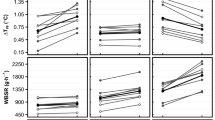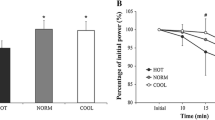Abstract
Multiple heterogeneous groups of subjects (both sexes and a wide range of maximal oxygen uptake V˙O2 max , body mass, body surface area (A D),% body fat, and A D/mass coefficient) exercised on a cycle ergometer at a relative (%V˙O2max, REL) or an absolute (60 W) exercise intensity in a cool (CO 21°C, 50% relative humidity), warm humid (WH 35°C, 80%) and a hot dry (HD 45°C, 20%) environment. Rectal temperature (T re) responses were analysed for the influence of the individual's characteristics, environment and exercise intensity. Exposures consisted of 30-min rest, followed by 60-min exercise. The T re was negatively correlated with mass in all conditions. Body mass acted as a passive heat sink in all the conditions tested. While negatively correlated with V˙O2 max and V˙O2 max per kilogram body mass in most climates, T re was positively correlated with V˙O2 max and V˙O2 max per kilogram body mass in the WH/REL condition. Thus, when evaporative heat loss was limited as in WH, the higher heat production of the fitter subjects in the REL trials determined T re and not the greater efficiency for heat loss associated with high V˙O2 max . Body fatness significantly affected T re only in the CO condition, where, with low skin blood flows (measured as increases in forearm blood flow), the insulative effect of fat was pronounced. In the warmer environments, high skin blood flows offset the resistance offered by peripheral adipose tissue. Contrary to other studies, T re was positively correlated with A D/mass coefficient for all conditions tested. For both exercise types used, being big (a high heat loss area and heat capacity) was apparently more beneficial from a heat strain standpoint than having a favourable A D/mass coefficient (high in small subjects). The total amount of variance in T re responses which could be attributed to individual characteristics was dependent on the climate and the type of exercise. Though substantial for absolute exercise intensities (52%–58%) the variance explained in T re differed markedly for relative intensities: 72% for the WH climate with its limited evaporative capacity, and only 10%–26% for the HD and CO climates. The results showed that individual characteristics play a significant role in determining the responses of body core temperature in all conditions tested, but their contribution was low for relative exercise intensities when evaporative heat loss was not restricted. This study demonstrated that effects of individual characteristics on human responses to heat stress cannot be interpreted without taking into consideration both the heat transfer properties of the environment and the metabolic heat production resulting from the exercise type and intensity chosen. Their impact varies substantially among conditions.
Similar content being viewed by others
Author information
Authors and Affiliations
Additional information
Accepted: 4 July 1997
Rights and permissions
About this article
Cite this article
Havenith, G., Coenen, J., Kistemaker, L. et al. Relevance of individual characteristics for human heat stress response is dependent on exercise intensity and climate type. Eur J Appl Physiol 77, 231–241 (1998). https://doi.org/10.1007/s004210050327
Issue Date:
DOI: https://doi.org/10.1007/s004210050327




